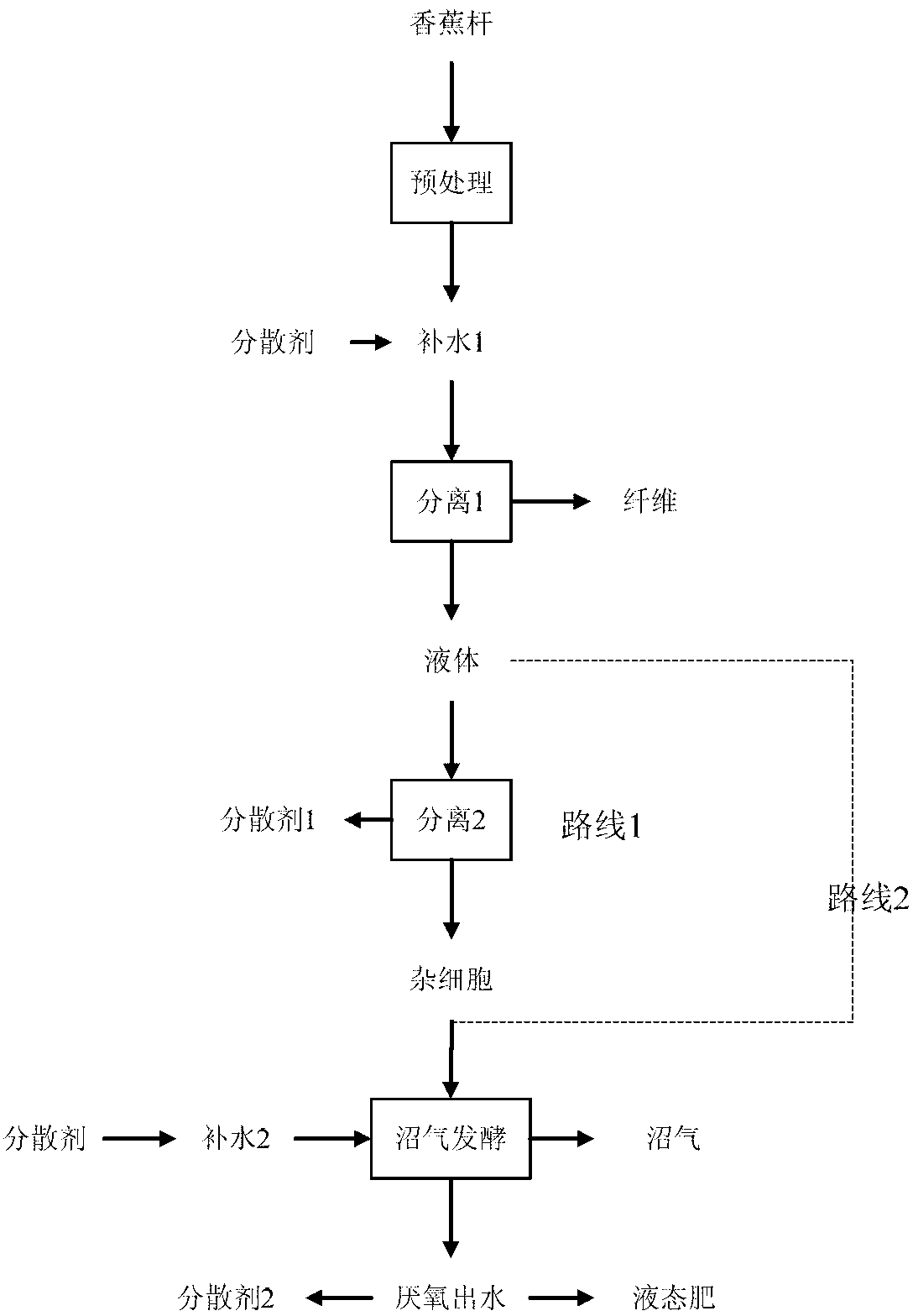Integrated utilization method of banana stalk
A technology of banana stalks and materials, applied in organic fertilizers, fiber mechanical separation, waste fuel, etc., can solve the problems of pumps being entangled in fibers, sludge loss, and difficulties in the further use of fibers, so as to avoid hidden dangers of pollution and improve feasibility , to achieve the effect of repeated use
- Summary
- Abstract
- Description
- Claims
- Application Information
AI Technical Summary
Problems solved by technology
Method used
Image
Examples
Embodiment 1
[0032] A kind of method of comprehensively utilizing banana bar of the present invention adopts the following steps:
[0033] (1) Raw material pretreatment: Take 1 ton of fresh banana stems and crush them with a beater;
[0034] (2) Dispersion: Transport the material obtained in (1) to the regulating tank through a bucket elevator, and add 1 ton of anaerobic effluent obtained in step (4) for dispersion;
[0035] (3) Fiber acquisition: the material obtained in (2) is separated by a grid to obtain 0.6 tons of fiber components and 1.4 tons of liquid;
[0036] (4) Biogas fermentation: transport the materials obtained in (3) to an anaerobic fermentation system for biogas fermentation, and obtain 10 cubic meters of methane and 1.4 tons of anaerobic effluent.
[0037] For the first fermentation, replace the dispersant with fresh water.
Embodiment 2
[0039] A kind of method of comprehensively utilizing banana bar of the present invention adopts the following steps:
[0040] (1) Raw material pretreatment: Take 1 ton of fresh banana stems and grind them through a grinder;
[0041] (2) Dispersion: transport the material obtained in (1) to the adjustment tank through a bucket elevator, and add 5 tons of dispersant obtained in step (4) for dispersion;
[0042] (3) Fiber acquisition: the material obtained in (2) is separated by a grid to obtain 0.2 tons of fiber components and 5.8 tons of liquid;
[0043] (4) Miscellaneous cell acquisition: Obtain 0.8 tons of miscellaneous cells and 5 tons of dispersant from the liquid obtained in (3) through the grid;
[0044] (5) Miscellaneous cell dispersion: Take 1.2 tons of anaerobic effluent obtained in step (6) and mix with the miscellaneous cells obtained in (4), and obtain 2 tons of materials with a dry matter content of 60 kg (dry matter content 6%);
[0045] (6) Biogas fermentation:...
Embodiment 3
[0048] A kind of method of comprehensively utilizing banana bar of the present invention adopts the following steps:
[0049] (1) Raw material pretreatment: Take 1 ton of fresh banana stems and grind them through a grinder;
[0050] (2) Dispersion: Transport the material obtained in (1) to the regulating tank through a bucket elevator, add 1.6 tons of dispersant for dispersion, and the dispersant includes 0.6 tons of dispersant obtained in step (4) and 1 ton of anaerobic effluent ;
[0051] (3) Fiber acquisition: the material obtained in (2) is separated by a grid to obtain 0.4 tons of fiber components and 2.2 tons of liquid;
[0052] (4) Miscellaneous cell acquisition: 0.6 tons of miscellaneous cell components and 1.6 tons of dispersant are obtained from the liquid obtained in (3) through the grid;
[0053] (5) Miscellaneous cell dispersion: Mix 0.4 tons of dispersant with the miscellaneous cells obtained in (4) to obtain 1 ton of material with a dry matter content of 6%; ...
PUM
 Login to View More
Login to View More Abstract
Description
Claims
Application Information
 Login to View More
Login to View More - R&D
- Intellectual Property
- Life Sciences
- Materials
- Tech Scout
- Unparalleled Data Quality
- Higher Quality Content
- 60% Fewer Hallucinations
Browse by: Latest US Patents, China's latest patents, Technical Efficacy Thesaurus, Application Domain, Technology Topic, Popular Technical Reports.
© 2025 PatSnap. All rights reserved.Legal|Privacy policy|Modern Slavery Act Transparency Statement|Sitemap|About US| Contact US: help@patsnap.com

